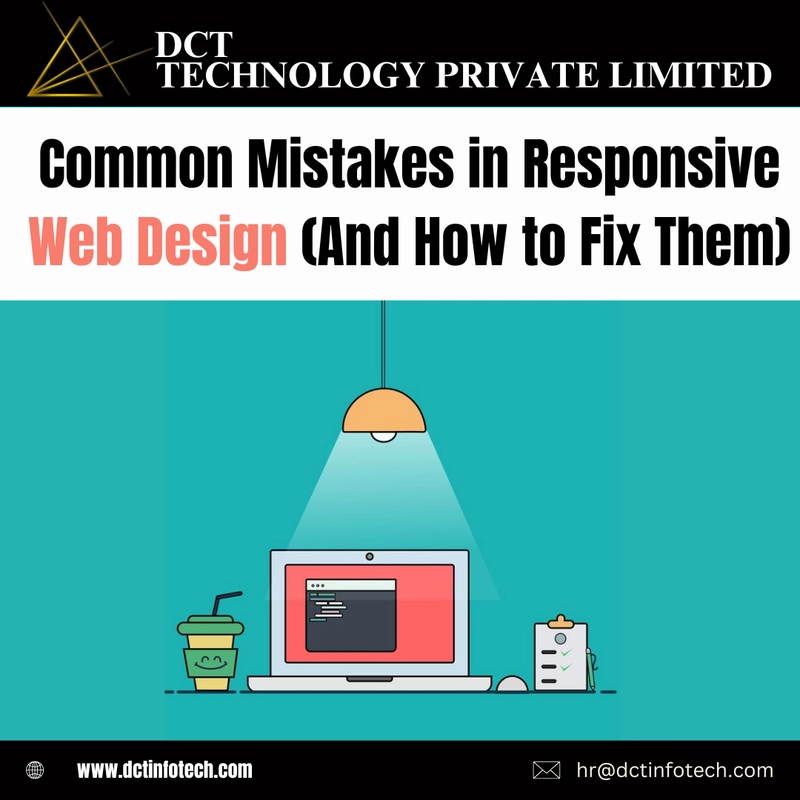🚨
We’ve all been there. You build a beautiful website, test it on your laptop, and boom — it’s perfect. But then a client views it on their phone... and suddenly it’s a mess.
Responsive design isn’t just about shrinking layouts — it’s about adapting experiences. And yet, so many developers (even experienced ones) still fall into the same traps.
Let’s break down the most common mistakes in responsive web design — and more importantly, how you can fix them fast.
1. 📏 Using Fixed Widths Instead of Flexible Units
Hardcoding widths with px can cause serious layout issues on smaller screens.
✅ Fix it with relative units like em, rem, %, and vw.
/* Instead of this */
.container {
width: 960px;
}
/* Do this */
.container {
width: 90%;
max-width: 960px;
}
Check out CSS Units Reference on MDN for a deep dive.
2. 📱 Ignoring the Viewport Meta Tag
Without the viewport meta tag, your responsive styles won’t behave as expected on mobile devices.
✅ Make sure this line is in your <head>:
<meta name="viewport" content="width=device-width, initial-scale=1.0">
You’d be surprised how often this is missing!
3. 🧱 Not Using a Mobile-First Approach
Designing for desktop first and then trying to scale down? That’s backwards.
✅ Flip it: design for mobile, then enhance for larger screens using media queries.
/* Mobile first */
.button {
font-size: 1rem;
}
/* Enhance for larger screens */
@media (min-width: 768px) {
.button {
font-size: 1.2rem;
}
}
Learn more in this guide: Mobile-First Design: Why It’s Crucial
4. 🔍 Overlooking Touch Targets
Tiny buttons on mobile = frustrated users.
✅ Ensure buttons, links, and form fields are at least 48x48px with enough spacing.
Bonus: Test your tap targets using Google’s Mobile-Friendly Test
5. 🖼️ Not Optimizing Images Responsively
A full-width 2MB image on a 375px screen? That’s a nightmare.
✅ Use srcset and sizes to serve the right image at the right resolution.
<img
src="img-large.jpg"
srcset="img-small.jpg 480w, img-medium.jpg 800w, img-large.jpg 1200w"
sizes="(max-width: 600px) 480px, (max-width: 960px) 800px, 1200px"
alt="Responsive Image">
Great article: Responsive Images - MDN
6. 🧪 Skipping Real Device Testing
Emulators ≠ real experience. What looks good in dev tools might break on actual devices.
✅ Test on real smartphones, tablets, and different browsers.
Pro tip: Use BrowserStack or Responsively App for fast device previews.
7. 📂 Forgetting to Organize CSS Responsively
Spaghetti media queries make your code unmaintainable.
✅ Group media queries logically OR use modern frameworks like Tailwind CSS which make responsive design simpler and more readable.
Tailwind example:
<div class="text-base md:text-lg lg:text-xl">
Responsive text size!
</div>
Explore: Tailwind Responsive Design Docs
8. 🧩 Overcomplicating Layouts with Too Many Breakpoints
You don’t need 10 breakpoints. You need strategic ones.
✅ Focus on 3–4 key breakpoints based on actual content needs:
-
sm: 640px (phones) -
md: 768px (tablets) -
lg: 1024px (laptops) -
xl: 1280px (desktops)
9. ❌ Hiding Content on Mobile Instead of Reworking It
Hiding half your content with display: none;? That’s not responsive — that’s lazy.
✅ Think content-first. Reorganize and reflow instead of removing.
Resource: Designing Content-First for the Web
10. 📉 No Performance Budget
Your site might look responsive, but does it feel fast?
✅ Monitor loading time, bundle size, and lazy-load heavy assets.
Helpful tool: Lighthouse
🚀 Ready to Level Up Your Responsive Game?
These aren’t just small tweaks — fixing these issues can massively improve UX, SEO, and retention across devices.
✅ Share your thoughts — which mistake have you faced the most?
💬 Drop your experience or solution in the comments — let’s learn together.
📌 Follow [DCT Technology]for more practical tips on Web Development, Design, SEO, and IT Consulting.



Top comments (0)